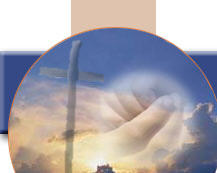



|
|
Overview |
|

![]()
Conclusion:
Dynamic Sacramental Life
Vincent Van Gogh created a painting in 1889 entitled ‘Starry Night, Saint
Rémy. It has electrifying energy expressing his turbulent, tormented
personality. It is full of creative life and the understanding of the
relationship between the world we know on earth and the vast expanses of he
universe. The central village church of Saint Rémy and the lights in the
village cottages link the earth with the immensity of the starry heavens.
All are part of the same, immense, harmonious creation.
For Christians, what happened on the first Easter Sunday after the torment
of Good Friday validated all that had happened in Jesus’ life up until that
Good Friday afternoon. That turbulent afternoon gives way to a creative
energy that recreates human life. This is the day of a new era when human
life intersects with the immense mystery of divine life known and celebrated
in the person of Jesus.
Full creative, harmonious life is to live in the image of that life of
Jesus, in the spirit of all his words and action that led up to that first
Good Friday.
The Church is the first fruit of the Resurrection., It is the light in the
darkness, like the stars and the cottage lights speaking into the darkness
of Saint Rémy. Its community life remembers Jesus and enables it to live as
a sacrament of his creative life. This sacramentality of the Church
developed into seven intensive moments that enable and inspires us to
function as the community of Jesus ion our everyday life in the world.
The key to dynamism in our Church life and in sacramental celebration is
this link with life and creation. If this link with life is not there we
have mere rituals, we have a God who is up there somewhere, a church that is
beyond the needs and dilemmas of life on this planet. Real life is our
agenda when talking of sacramental dynamism. Sacraments are structures of
grace that help us speak of ‘life in all its fullness’ in our world. They
help us tap into our potential.
The sacraments involve us in an existence shaped by symbolic activity. They
tell us that we are more than just a group of people. We are people who
identify with the persona and mission of Jesus. We are a people, not closed
in on ourselves, but ministering Jesus’ saving, expansive grace. We are
people with a mission to bring in the Reign of God.
Sacraments invite us to consider what life could be if we allowed their
meaning to penetrate all the areas of our life. What could life be and mean
if we were symbols of Jesus in our town, our suburb? To make this real we
must continually look to what Jesus did and said. That is why Sunday is an
agenda item for Christians. It is the day of resurrection, a day to
appreciate God’s presence, to remember who we are in this new era.
The ultimate aim of the Church as sacrament is that we recognize and
appreciate God in all creation and in each person; to identify even, and
especially, the most marginalized as the beloved of God. The ultimate aim of
any sacramental celebrations is the appreciation of the God of Jesus with
our community speaking to all people at these intensive moments of birth,
growth, relationship, crisis, illness, dying, death. To achieve these
ultimate aims is the goal of the renewal of sacramental theology.
Rites can appear meaningless. They can appear to many as a bit of medieval
piety that helps with the ‘big times’ like births, deaths and marriages, but
sacraments are not always seen as giving dynamic energy to everyday life. In
fact, it can be quite the opposite, with ‘irrelevant’ and ‘boring’ being the
words used to describe them.
If, on the other hand, our rituals become celebrations of the real life of
the community, them when we can express in ways relevant to our lifestyle,
the meaning of these intense moments, then we will know and appreciate the
God who is with us on our journey.
Some are worried by this renewal and speak as though sacramental practice is
something that must remain set in the expressions and rituals of the past.
Yet, the use Van Gogh’s “Starry Night’ again, we remember that once there
was the idea that the wile of create was complete and there was nothing new.
Yet we know now that new stars continue to be. The work of creation goes on.
So, too, the Church and all Christians are in a continual process of
transformation. We are all part of creation. This is a process of the
enlightening Holy Spirit. Enabled by that Spirit, may we appreciate our God,
not in dogmatic statements and ‘rituals’, but in discovering celebrations
that express life’s meaning in Jesus.
The journey continues…
|
|
|


Copyright © Anthony Kain 2009